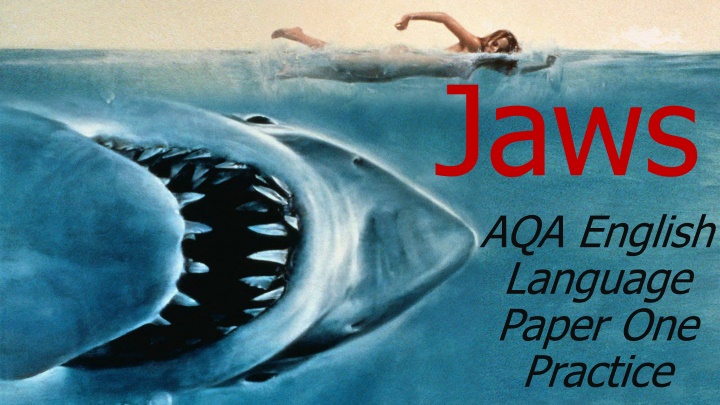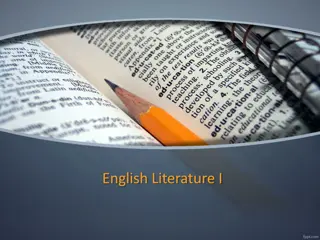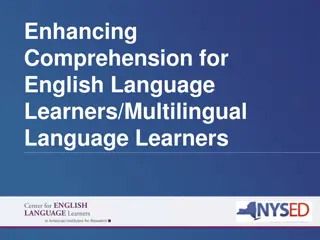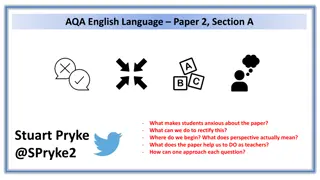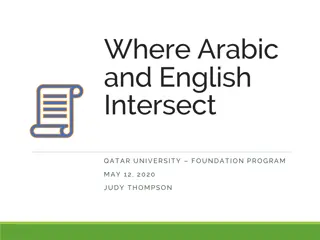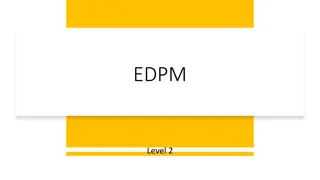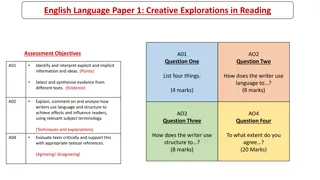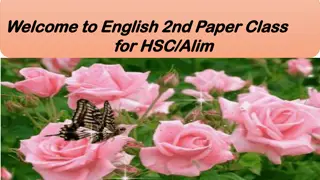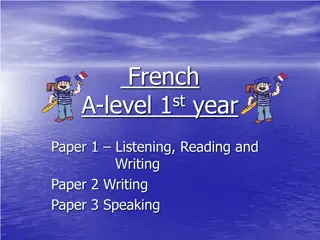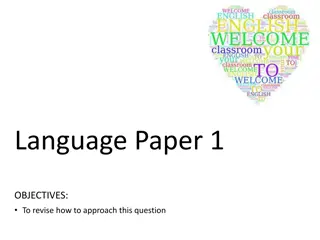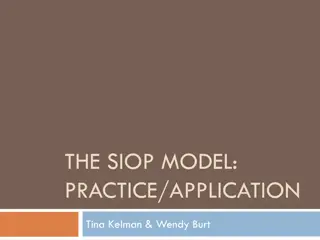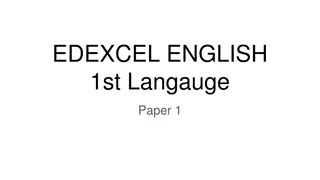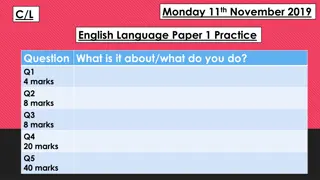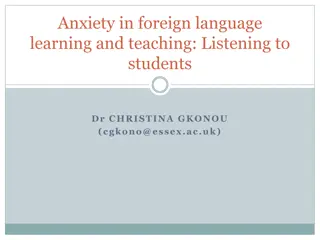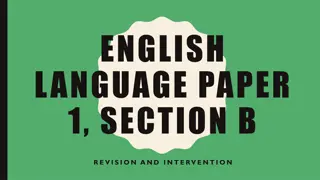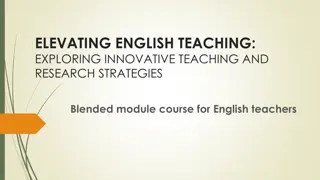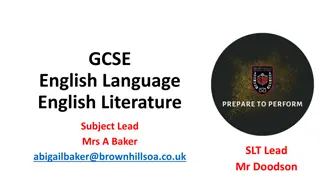English Language Paper 1 Practice Tips and Strategies
Enhance your English Language Paper 1 skills with helpful tips and strategies to tackle fictional sources effectively. Practice active reading, analyze author's intentions, make notes, and respond confidently to exam questions. Get guidance on structuring responses, engaging with the text, and developing your writing skills for Q1 to Q5. Boost your confidence and performance in Paper 1 revision sessions with these valuable insights.
Download Presentation

Please find below an Image/Link to download the presentation.
The content on the website is provided AS IS for your information and personal use only. It may not be sold, licensed, or shared on other websites without obtaining consent from the author.If you encounter any issues during the download, it is possible that the publisher has removed the file from their server.
You are allowed to download the files provided on this website for personal or commercial use, subject to the condition that they are used lawfully. All files are the property of their respective owners.
The content on the website is provided AS IS for your information and personal use only. It may not be sold, licensed, or shared on other websites without obtaining consent from the author.
E N D
Presentation Transcript
Jaws AQA English Language Paper One Practice
Source A In Paper One of the exam, you will receive one fictional source to respond to. This source will be an extract taken from a 20thor 21stcentury literary text. The extract we are practising with today is taken from Peter Benchley s Jaws, published in 1974.
Active Reading of the Source Do not jump straight to answering the questions; take some time to read the source through. Try to determine exactly what the author is trying to show you by the end of the extract, and how the extract makes you feel. Ask yourself the question: have any of these ideas developed or changed by the end? Make notes about what is happening/being focused on/being described by the narrator alongside each paragraph as you read.
ENGLISH LANGUAGE PAPER 1 REVISION Need to spend 10 minutes READING the text CAREFULLY maybe even twice! Q5- 40 marks Write a story or a description based on an image. Q1- 4 marks Q2- 8 marks Q3- 8 marks Q4- 20 marks
ENGLISH LANGUAGE PAPER 1 REVISION Need to spend 10 minutes READING the text CAREFULLY maybe even twice! Q1- List four things Q2- How does the writer use LANGUAGE to.. Q3- How does the writer STRUCTURE the text to Q4- A student said ______ to what extent d you agree? Q5- 40 marks Write a story or a description based on an image.
ENGLISH LANGUAGE PAPER 1 REVISION Need to spend 10 minutes READING the text CAREFULLY maybe even twice! Top tip: Read the questions first before reading 1.List four things that you learn about the boy in paragraph 2. 2.Look at the last paragraph, how has the writer structured the text to describe the shark attack in a horrific way? 3.How has the writer structured the text to interest the reader? 4.A student having read this extract said The narrator makes you feel like you are close to the shark attack as though you had seen it happen from a boat a few metres away To what extent do you agree?
Q1 List four things that you learn about the boy in paragraph one (4 marks) Tips: Write in full sentences. The boy is brave and not afraid of water. Don t have VERY explicit things because you won t stand out amongst the rest and risk not getting a mark if it s too simple. e.g. The boy had ankles in the water
Answers he was resting in the water his arms were dangling down his feet and ankles were dipping in and out of the water his head was turned towards shore he noticed he d been carried out further than he should be he could see his mum lying on the towel/ a man and child playing he was not afraid he was not far from the shore he wanted to get closer before his mother saw him he eased himself back a little his arms displaced the water almost silently his kicking feet made splashes
Q3 How has the writer structured the text to interest the reader. What s the narrative focus in the beginning, middle and end? How does the tone/mood change across the text? What s the pace like (slow/fast) and does it change? How does THE READER feel as we go through the text? What new information do we learn that increase tension?
Q3 How has the writer structured the text to interest the reader. Task One: Task Two: Go through the text and outside EVERY paragraph note down what the focus is. Go through the text and outside EVERY paragraph note down what the tone is like. e.g. Paragraph One: focus on an unknown fish e.g. Paragraph One: calm tone to relax reader.
Useful STRUCTURE sentences Useful STRUCTURE sentences The extract begins with a focus on As the text develops, the writer shifts the focus to The focus at the endshifts to The ending reminds the reader that The ending encourages the reader to feel
Q3 How has the writer structured the whole text to interest the reader. The writer in the beginning focuses on an unknown fish swimming innocently in the sea because it says the great fish swam slowly its tail waving . This creates a calm tone at the beginning to make the reader not suspect that any danger is ahead. Also the writer focuses on an unknown fish rather than a shark to trap the reader in a false sense of security that this fish is just a calm creature. What is the focus on? Evidence Explain the effect on the reader This creates . This makes the reader This sets a . This suggests
Q3 How has the writer structured the whole text to interest the reader. As the text develops, the focuses shifts to a boy who has drifted on a boat at sea on his own because it says he had noticed that he had been carried out . This slightly lessens the calm tone at the start because even though the boy is relaxed dipping in and out of the water , the writer has heightened some anxiety for the reader here because the boy has drifted away from his mother and he could be at threat of drowning or getting too lost at sea. The writer pays attention to the boys relaxed attitude too to further trap the reader in the false sense of security that was created at the start with the unknown fish. What is the focus on? Evidence Explain the effect on the reader This creates . This makes the reader This sets a . This suggests
Q3 How has the writer structured the whole text to interest the reader. At the start of the text, the writer deliberately focuses our attention on when it says . which creates What is the focus on? Evidence Explain the effect on the reader Write your answer See the whole text as a journey: what did we learn? How did we feel? When did things get realised? This creates . This makes the reader This sets a . This suggests
Question Two How does the writer use language to You will look at a small section the same extract and have to consider how the writer s choice of language has created a specific impact on readers. As a reader, think about the overall tone that is created. Highlight any words/phrases that create this effect. Comment on the effect of the use of specific language techniques, AND the impact on the reader (you!).
Question Two How does the writer use language to describe the shark s attack? what descriptive techniques have been used? what to focus on
Question Two The boy s last only thought was that he had been punched in the stomach. The breath was driven from him in a sudden rush. He had not time to cry out, nor had he had the time, would he have known what to cry, for he could not see the fish. The fish s head drove the raft out of the water. The jaws smashed together, engulfing head, arms, shoulder, trunk, pelvis and most of the raft. Nearly half the fish had come clear of the water, and it slid forward and down in a belly flopping motion, grinding the mass of flesh and bone and rubber. The boy s legs were severed at the hip, and they sank, spinning slowly to the bottom.
Question Two the boy s last only thought What language technique has been employed? What impression does this create? shows how quickly and out-of-the-blue the attack happened parenthesis What specific words create this technique? The word only
Question Two The writer s use of parenthesis in the quotation, the boy s last only thought shows how rapidly the attack happened and how quickly the boy has been killed by the shark, which demonstrates the shark s power. This creates sympathy from the reader because he is a young child whose future is lost.
Question Two the jaws smashed together What language technique has been employed? What impression does this create? shows destructive capabilities of the shark and its attack on the boy verb phrase What specific words create this technique? The verb smashed
Question Two The verb phrase the jaws smashed together shows the destructive capabilities of the shark during its attack on the boy. The use of the determiner the instead of its gives the shark s jaws a formidable power of their own, demonstrating to the reader that they are something to fear.
Question Two Choose one of the following uses of language to analyse in more detail, as previously demonstrated: The use of listing in the quotation, engulfing head, arms, shoulder, trunk, pelvis and most of the raft The use of imagery in the quotation, grinding the mass of flesh and bone and rubber Challenge: theuse of sibilance in the quotation, they sank, spinning slowly to the bottom
Exemplar Answers The use of listing in the quotation, engulfing head, arms, shoulder, trunk, pelvis and most of the raft suggests that the shark has consumed almost every part of the boy and his raft, signifying its immense strength and hunger for blood. The ordering of the body parts allows the reader to imagine the boy being swallowed head first, inciting fear in the reader. The use of imagery in the quotation, grinding the mass of flesh and bone and rubber reveals the outcome of the shark s attack: it has reduced the young boy to nothing but a bloody mess. The imagery is violent and uncomfortable for the reader, who is likely to be horrified by his death. The use of sibilance in the quotation, they sank, spinning slowly to the bottom creates a softer tone than the previous descriptions, leaving a harrowing impression on the reader as the last whole part of the boy sinks slowly to the bottom of the sea. The shark s attack has completely destroyed him.
